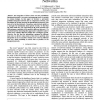Free Online Productivity Tools
i2Speak
i2Symbol
i2OCR
iTex2Img
iWeb2Print
iWeb2Shot
i2Type
iPdf2Split
iPdf2Merge
i2Bopomofo
i2Arabic
i2Style
i2Image
i2PDF
iLatex2Rtf
Sci2ools
85
Voted
CIBCB
2007
IEEE
2007
IEEE
Motifs and Modules in Fractured Functional Yeast Networks
The integration of diverse data sets into probabilistic functional networks is an active and important area of research in systems biology. In this paper we fracture a previously published integrated network into its component networks, and investigate the overlap between the information provided by each data set to the final network. Using three-node network motifs as a surrogate for information about genetic circuits, we find that the same motifs are over-represented in all of the networks, but different genes contribute to the motifs in different data sets. We conclude that the data integration approach is valuable because it clearly does combine different insights into a biological system. However, the fact that the information contained in different data sets is so diverse raises issues of how best to perform data integration so as to accurately estimate error rates for different data sets, whilst including as much data as possible in the integrated network.
Related Content
| Added | 02 Jun 2010 |
| Updated | 02 Jun 2010 |
| Type | Conference |
| Year | 2007 |
| Where | CIBCB |
| Authors | Jennifer Hallinan, Anil Wipat |
Comments (0)

